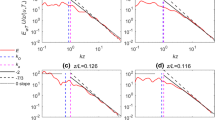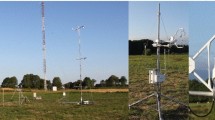Abstract
Vertical profiles of temperature, water vapour, and carbon dioxide (\(\mathrm {CO}_{2}\,\)) densities are analyzed, together with the respective turbulent fluxes of these scalars during 9 nights when there was a consistent wind decay along the period, with a corresponding stable boundary layer regime transition from weak to very stable. The purpose is to understand whether the vertical gradients and fluxes of these scalars respond differently to the mean wind decay. A multi-resolution spectral decomposition is used to address how the patterns found depend on their temporal scale. Case studies show that only water vapour gradients and latent heat fluxes switch sign along the nights. The signs of sensible heat and \(\mathrm {CO}_{2}\,\) fluxes on low-frequency scales oppose those on turbulent time scales, while the same does not always occur for latent heat. The covariance between fluctuations of temperature and those of both water vapour and \(\mathrm {CO}_{2}\,\) are also analyzed, along with their spectral decompositions. Their role in the corresponding scalar flux budgets is evaluated by comparing two relevant terms in the budget equations. It is found that the term related to the vertical gradient exceeds the one related to the temperature–scalar covariance for wind speeds above a threshold, which is larger for latent heat flux than for both sensible heat and \(\mathrm {CO}_{2}\,\) fluxes. The implications of this result for flux parametrizations are addressed.











Similar content being viewed by others
References
Acevedo OC, Mahrt L (2010) Systematic vertical variation of mesoscale fluxes in the nocturnal boundary layer. Boundary-Layer Meteorol 135(1):19–30
Acevedo OC, Moraes OL, Fitzjarrald DR, Sakai RK, Mahrt L (2007) Turbulent carbon exchange in very stable conditions. Boundary-Layer Meteorol 125(1):49–61
Acevedo OC, Costa FD, Oliveira PE, Puhales FS, Degrazia GA, Roberti DR (2014) The influence of submeso processes on stable boundary layer similarity relationships. J Atmos Sci 71(1):207–225
Acevedo OC, Mahrt L, Puhales FS, Costa FD, Medeiros LE, Degrazia GA (2016) Contrasting structures between the decoupled and coupled states of the stable boundary layer. Q J Roy Meteorol Soc 142(695):693–702
Acevedo OC, Degrazia GA, Puhales FS, Martins LGN, Oliveira PES, Teichrieb C, Silva SM, Maroneze R, Bodmann B, Mortarini L, Cava D, Anfossi D (2018) Monitoring the micrometeorology of a coastal site next to a thermal power plant from the surface to 140 m. Bull Am Meteorol Soc 99(4):725–738
Acevedo OC, Maroneze R, Costa FD, Puhales FS, Degrazia GA, Nogueira Martins LG, Soares de Oliveira PE, Mortarini L (2019) The nocturnal boundary layer transition from weakly to very stable. Part i: Observations. Q J Roy Meteorol Soc 145(725):3577–3592
Andreae MO, Acevedo OC, Araùjo A, Artaxo P, Barbosa CGG, Barbosa HMJ, Brito J, Carbone S, Chi X, Cintra BBL, da Silva NF, Dias NL, Dias-Júnior CQ, Ditas F, Ditz R, Godoi AFL, Godoi RHM, Heimann M, Hoffmann T, Kesselmeier J, Könemann T, Krüger ML, Lavric JV, Manzi AO, Lopes AP, Martins DL, Mikhailov EF, Moran-Zuloaga D, Nelson BW, Nölscher AC, Santos Nogueira D, Piedade MTF, Pöhlker C, Pöschl U, Quesada CA, Rizzo LV, Ro CU, Ruckteschler N, Sá LDA, de Oliveira Sá M, Sales CB, dos Santos RMN, Saturno J, Schöngart J, Sörgel M, de Souza CM, de Souza RAF, Su H, Targhetta N, Tóta J, Trebs I, Trumbore S, van Eijck A, Walter D, Wang Z, Weber B, Williams J, Winderlich J, Wittmann F, Wolff S, Yáñez Serrano AM (2015) The amazon tall tower observatory (atto): overview of pilot measurements on ecosystem ecology, meteorology, trace gases, and aerosols. Atmos Chem Phy 15(18):10723–10776
Aubinet M, Vesala T, Papale D (2012) Eddy covariance: a practical guide to measurement and data analysis. Springer, Berlin
Baldocchi D (2008) ‘Breathing’ of the terrestrial biosphere: lessons learned from a global network of carbon dioxide flux measurement systems. Aust J Bot 56(1):1–26
Cava D, Katul G, Sempreviva AM, Giostra U, Scrimieri A (2008) On the anomalous behaviour of scalar flux-variance similarity functions within the canopy sub-layer of a dense alpine forest. Boundary-Layer Meteorol 128(1):33–57
Dias NL, Brutsaert W (1996) Similarity of scalars under stable conditions. Boundary-Layer Meteorol 80(4):355–373
Donaldson CD (1972) Calculation of turbulent shear flows for atmospheric and vortex motions. AIAA J 10(1):4–12
Edwards JM, Beljaars AC, Holtslag AA, Lock AP (2020) Representation of boundary-layer processes in numerical weather prediction and climate models. Boundary-Layer Meteorol 177(2):511–539
Falge E, Aubinet M, Bakwin P, Baldocchi D, Bergigier P, Bernhofer C, Black T, Ceulemans R, Davis K, Dolman A, Goldstein A, Goulden M, Granier A, Hollinger D, Jarvis P, Jensen N, Pilegaard K, Katul G, Kyaw Tha Paw P, Law B, Lindroth A, Loustau D, Mahli Y, Monson R, Moncrieff P, Moors E, Munger J, Meyers T, Oechel W, Schulze ED, Thorgeirsson H, Tenhunen J, Valentini R, Verma S, Vesala T, Wofsy S (2017) Fluxnet research network site characteristics, investigators, and bibliography (2016)
Fuentes J, Wang D (1999) On the seasonality of isoprene emissions from a mixed temperate forest. Ecol Appl 9(4):1118–1131
Fuentes JD, Chamecki M, dos Santos RMN, Randow CV, Stoy PC, Katul G, Fitzjarrald D, Manzi A, Gerken T, Trowbridge A, Freire LS, Ruiz-Plancarte J, Maia JMF, Tóta J, Dias N, Fisch G, Schumacher C, Acevedo O, Mercer JR, Yañez-Serrano AM (2016) Linking meteorology, turbulence, and air chemistry in the amazon rain forest. Bull Am Meteorol Soc 97(12):2329–2342
Ha KJ, Mahrt L (2003) Radiative and turbulent fluxes in the nocturnal boundary layer. Tellus A Dyn Meteorol Oceanogr 55(4):317–327
Hong J, Kim J, Ishikawa H, Ma Y (2010) Surface layer similarity in the nocturnal boundary layer: the application of Hilbert–Huang transform. Biogeosciences 7(4):1271–1278
King J, Anderson P (1994) Heat and water vapour fluxes and scalar roughness lengths over an Antarctic ice shelf. Boundary-Layer Meteorol 69(1):101–121
Li D, Bou-Zeid E, De Bruin HAR (2012) Monin–Obukhov similarity functions for the structure parameters of temperature and humidity. Boundary-Layer Meteorol 145(1):45–67
Mahrt L (1998) Nocturnal boundary-layer regimes. Boundary-Layer Meteorol 88(2):255–278
Mahrt L (2010) Computing turbulent fluxes near the surface: needed improvements. Agric For Meteorol 150(4):501–509
Mallat SG (2009) A theory for multiresolution signal decomposition: the wavelet representation. In: Fundamental papers in wavelet theory. Princeton University Press, Princeton, pp 494–513
Massman W, Lee X (2002) Eddy covariance flux corrections and uncertainties in long-term studies of carbon and energy exchanges. Agric For Meteorol 113(1–4):121–144
Stefanello M, Cava D, Giostra U, Acevedo O, Degrazia G, Anfossi D, Mortarini L (2020) Influence of submeso motions on scalar oscillations and surface energy balance. Q J R Meteorol Soc 146(727):889–903
Stull RB (1988) An introduction to boundary layer meteorology, vol 13. Springer, Berlin
Sun J, Mahrt L, Banta RM, Pichugina YL (2012) Turbulence regimes and turbulence intermittency in the stable boundary layer during cases-99. J Atmos Sci 69(1):338–351
Vickers D, Mahrt L (2003a) The cospectral gap and turbulent flux calculations. J Atmos Ocean Technol 20(5):660–672
Vickers D, Mahrt L (2003b) The cospectral gap and turbulent flux calculations. J Atmos Ocean Technol 20(5):660–672
Vickers D, Mahrt L (2006) A solution for flux contamination by mesoscale motions with very weak turbulence. Boundary-Layer Meteorol 118(3):431–447
Wang S, Pan M, Mu Q, Shi X, Mao J, Brümmer C, Jassal RS, Krishnan P, Li J, Black TA (2015) Comparing evapotranspiration from eddy covariance measurements, water budgets, remote sensing, and land surface models over canada. J Hydrometeorol 16(4):1540–1560
Warhaft Z (1976) Heat and moisture flux in the stratified boundary layer. Q J R Meteorol Soc 102(433):703–707
Webb EK, Pearman GI, Leuning R (1980) Correction of flux measurements for density effects due to heat and water vapour transfer. Q J Roy Meteorol Soc 106(447):85–100
Van de Wiel B, Moene A, Jonker H, Baas P, Basu S, Donda J, Sun J, Holtslag A (2012) The minimum wind speed for sustainable turbulence in the nocturnal boundary layer. J Atmos Sci 69(11):3116–3127
Zahn E, Dias NL, Araújo A, Sá LD, Sörgel M, Trebs I, Wolff S, Manzi A (2016) Scalar turbulent behavior in the roughness sublayer of an Amazonian forest. Atmos. Chem Phys 16(17):11349–11366
Acknowledgements
The study has been developed within the context of a Research and Development project sponsored by companies Linhares Geração S.A. and Termelétrica Viana S.A. The Research and Development programme is regulated by Brazilian National Agency for Electric Energy. The authors thank deeply all support provided by these companies for the development of the present work. The study also has been partially supported by Brazilian funding agencies CNPq (Grant 307024/2017-2) and CAPES. The latter funds graduate studies of the first author.
Author information
Authors and Affiliations
Corresponding author
Additional information
Publisher's Note
Springer Nature remains neutral with regard to jurisdictional claims in published maps and institutional affiliations.
Rights and permissions
About this article
Cite this article
Pinheiro, M.E.O., de Oliveira, P.E.S. & Acevedo, O.C. Wind-Speed Controls on Scalar Gradients, Fluxes, and Cospectra in the Stable Boundary Layer. Boundary-Layer Meteorol 183, 79–96 (2022). https://doi.org/10.1007/s10546-021-00671-9
Received:
Accepted:
Published:
Issue Date:
DOI: https://doi.org/10.1007/s10546-021-00671-9




